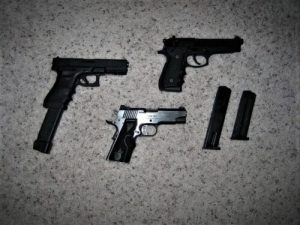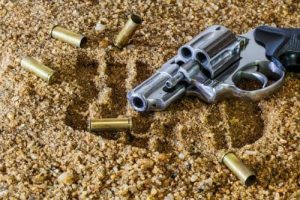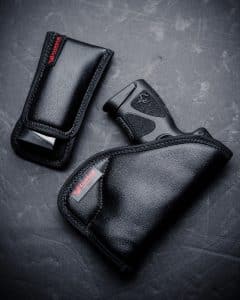
Sig P238 VS Springfield 911
SIG P238 vs Springfield 911
A Holistic Comparison
What a time it is to be alive and be a concealed carrier. At this point in the great concealed carry phenomenon, there are guns out there for every person of every size. There is no excuse not to carry a weapon, and if you search, you’ll find one that fits you. Two guns out there that exemplify ease of carrying is the SIG P238 vs Springfield 911.
Both are incredibly small guns, both built after the 1911 platform, and both are in 380 ACP. Does the question become which one is better overall? Can one be declared better? That’s a tough question, but let’s explore both guns and see how they stack up.
Side By Side
The SIG P238 is the slightly older brother in this race. When it premiered alongside the 938, the guns were welcome with open arms. Little mini 1911s in 9mm and 380 ACP small enough to pocket carry? Of course, the market was happy.
The 1911 design isn’t just proven, but an ergonomic design that is easy to learn and master. As an SAO gun, it promised a superior trigger to most pocket guns and an all-metal frame unheard of in a gun this small. It was an instant success, and SIG has since pushed out tons of different models that vary in both function and form.
The Springfield 911 is a new contender on the mini 1911 block. The name is clever, remove a one from 1911, and you get 911. Who do you call in emergencies? Exactly. Besides clever marketing, Springfield did produce an outstanding little gun that mimics the 1911 in many different ways.
The 911 rocks an ambidextrous safety, a stainless or blued slide, and everything about it is cut to be thin and lightweight. The Springfield 911 is an interesting entry into the concealed carry market and the first competition for the P238.
Sig P238 vs Springfield 911: Fit & Finish
Both guns have a very sleek and lithe look to them. Small, thin, and adorable is the best way to describe them. The 911 comes in either an all-black finish or a stainless and black finish.
The SIG P238 comes in so many different finishes it’s hard to keep up. Black, stainless, FDE, OD Green, chrome, gold, Cerakote Texas flag, and so on and so forth. The P238 has more finish options than I feel like listing.
Regardless, the finish is also handsome on both guns. SIG And Springfield are a little vain but in a good way. You know you are going to get a solid and evenly applied finish.
Both guns look fantastic, and at their price point, they can’t afford to be. I’m weak in the knees for stainless guns, so both guns give me plenty to be excited about.
In terms of fit and feel, both companies knock it out of the park. From the front to the back these guns are decked out and designed to work. On top of that, the controls are crisp.
The safeties are tactile and audible, the slide of the SIG feels like it’s on ball bearings and the 911 isn’t far behind on smoothness. Both guns are precision made, and it certainly shows.
Sig P238 vs Springfield 911: Specs
As pocket pistols, is the competition which is smaller and lighter? The 911 and P238 are nearly identical when it comes to complete specs. The SIG does weigh a little more at 15.2 ounces compared to the 911’s 12.6 ounces. Both guns have a 2.7-inch barrel, are 5.5 inches overall, and both a hair under 4 inches tall.
They are remarkably similar pistols, and this is likely about as short as you can go with these guns. Both guns come with two magazines, one holds six rounds, and the other holds seven rounds. The seven rounder isn’t flush but features a pinky extension. This increases the height of the gun by just a bit, but not terribly so.
Sig P238 vs Springfield 911: Ergonomics
Both guns are 1911 like, but a lot of the design is only skin deep. They are 1911ish, but not 1911s. Neither features a grip safety for example. Both do feature manual safeties placed in a familiar and usual position.
These frame-mounted safeties are easy to reach and positioned perfectly to be defeated by the thumb. Your thumb will naturally fall where the safety lies, and it’s easy to defeat with the thumb.
The Springfield 911 comes with built-in ambidextrous safety. The SIG P238 comes in either a standard right-hand safety, and there are also certain models that feature ambidextrous safeties.
The Springfield’s safety is thin and small, with a shelf that’s easy for the thumb to catch. The SIG safety has a little more mass to it and is just as easy to find.
Performance-wise I only noticed one small difference. The SIG safety is a bit more intuitive when it comes to putting the safety back on. It was a little easier for my fat thumb to get under and flick up.
Both guns have short grips, and what else do you expect from a pocket pistol? Both have 7 round magazines as an option with a small pinky extension. The extensions make the gun easy to hang onto with the full hand. I hate a hanging pinky, so the 6 round flush magazines don’t get much play. I like the extension, and it makes the whole system more comfortable.
The 911 offers fantastic looking and feeling G1 grips. These are thin, but tough and provide a solid grip with a nice overall aesthetic. There are models with Viridian laser grips that are a little thicker and pack a red dot laser.
The SIG P238 comes with Hogue wrap-around grips on most standard models, and these are fully functional. They are comfortable, work well and help with recoil distribution into the hand.
There are so many other models of the P238 you can find just about any grip material you want. Metal, wood, G10, Mother of Pearl, and likely plenty I’m forgetting.
Both guns feature a similar push-button magazine release, and both are pretty much the same. You get rear slide serrations, as well as large slide locks. The slide locks are both well done and quite wide. They are easy to reach and activate.
One thing I love about both guns is just how easy they are to rack. Pulling the slide rearward is very easy to do, especially if you thumb the hammer back before racking the slide. This makes both of these guns a great choice for shooters with bad hand strength.
Sig P238 vs Springfield 911:
The Sig P238 packs in two magazines, one hold seven rounds and has a pinky extension and one has six rounds and fits flush in the gun. The SIG comes with full-sized SIG NITE sights that glow quite brilliantly as the sun is setting. The SIG P238 is a small, but capable gun that’s designed for EDC, so night sights are an important addition.
Springfield took a few pages out of SIG’s book, and it comes with both a 7 round magazine with a pinky extension and flush fit 6 round magazine.
They followed them with the addition of night sights too. Springfield used Ameriglo Night Sights. They do feature brightly colored plastic inserts that make it easier to use the gun during the day. It’s a nice touch and a slight step above SIG.
Both guns have very similar outer and inner features. They both only have rear serrations, they are both SAO guns with light triggers, and both guns are designed for concealed carry.
The Springfield has a unique G10 trigger for better or worse, but I see no issues with it. Springfield also includes an ambidextrous thumb safety standard with the 911, and only some SIG models have an ambidextrous safety.
Sig P238 vs Springfield 911:
The words pocket-sized 380 often incite a certain cringe on the hands of those who’ve shot such little guns. Most people impression of a pocket-sized 380 comes from the Ruger LCP, the S&W Bodyguard, and other micro 380s that feature polymer frames and hand slapping recoil. They also often feature long, double-action triggers and minimal sights that make them a hassle to shoot.
The good news is neither the SIG P238 or the Springfield 911 possess such unfun features. The SIG P238 is the softest shooting pocket pistol I’ve ever fired, and the Springfield 911 is the second softest.
That little extra weight the SIG makes a slight difference when it comes to range time, but both guns are enjoyable to shoot. Recoil is less of a snappy high five and more of a gentle push rearward.
The light and short single-action triggers are both excellent. The SIG’s metal trigger feels a little more polished and slides with less grit. The Springfield 911’s G10 trigger is nice and clean, but you can feel that polymer isn’t as smooth as steel.
Both guns wear nice and big sights that are easy to see and well beyond what you usually get with a pocket 380. These are proper handgun sights that are quick and easy to align. This makes an appropriate sight picture possible and easy to obtain.
Both guns are modern and reliable with a variety of ammunition. This includes ball and JHPs. As a modern defensive pistol, you can’t afford it to choke, and neither gun chokes easily. They both digest, chew up and spit out everything you can put through it.
Both guns offer a generous beavertail that prevents hammer bite but does allow a nice and high grip. The downside is for guys like me. As a guy with a 2XL glove size, my hands tend to catch the slide here and there. This slide bite is uncomfortable, but I can deal with it.
The magazines of both guns aren’t the fastest to remove and reload. It is a pocket pistol, and some expectations have to be realistic.
These aren’t duty guns and aren’t designed for extended firefights. They are designed for realistic and typical defensive scenarios that require little to no shots ever fired.
On the range, these guns are fun to shoot, are a blast to train with. Very few 380 pocket pistols can say that.
Sig P238 vs Springfield 911: Ease of Concealment
Both guns are not only small but lightweight, at least lightweight for their metal frames. Their design makes them inherently thin, but there are a few areas that can be snagged easily.
They do of course need a safe and reliable holster. However, they are effortless to conceal. Even the most petite person can stash one of these guns with relative ease. They are also insanely easy to hide in almost any style of dress short of a Speedo.
One of the most universal ways to carry a small gun is appendix carry. Pocket carry is excellent, but appendix carry is a bit more intuitive, and a lot of women’s jeans don’t even have pockets.
The V3 Stingray by Clinger Holsters is one of the best Sig P238 holsters you’ll find, albeit we are a little biased. In addition, our durable Kydex Springfield 911 holsters are about as small and lightweight as you’ll find.
I feel it does at exemplifying the best parts of the Springfield and SIG. It’s lightweight, thin, easy to conceal and comfortable. While your 911 or P238 protects you, the Stingray will protect your gun.
Conclusion
Once the brass has hit the floor and the range is clear which model is better? Aye Yi Yi that’s a tough question. The P238 has been around a bit longer, so accessories and magazines are a little easier to find, but the 911 is going to be catching up shortly. Both guns are reliable, easy to shoot and look amazing.
I’m partial to the SIG because of how many different finishes and special models there are. This is purely a vanity choice. Regarding fit and function, both guns are perfectly capable of saving your life, defending your family, and being a fun gun to maintain proficiency with.
The best thing about the SIG P238 vs Springfield 911 is the fact you don’t have an excuse not to carry one. They work for any size person in nearly any form of dress. The only thing you’ll have to leave behind is your excuses.
Are you looking for a durable and modular gun holster for your new SIG P238 or Springfield 911? Check out our Kydex holsters here that will give you a lifetime supply of use.












